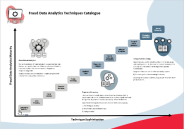Data: more than fraud detection
Data is becoming increasingly important in the fight against fraud. We know that fraudsters are diverse, dynamic and adapt quickly. As the Australian Government moves all services online by 2025, traditional responses to countering fraud will be less effective. But there is good news – there is more data available than ever to deliver better, and more secure government services that can improve all aspects of your fraud operating model.
International good practice shows the best way to deal with fraud is to prevent it. This will require capability and focus, just like it does in the banking and private sector. If we are to build a secure foundation of integrity for the APS and for future government services we must act now to increase our capacity to prevent fraud through transparent and appropriate access, sharing and use of data.
How the new Data Availability and Transparency Scheme can help you prevent fraud
On 30 March 2022, the Federal Parliament passed the Data Availability and Transparency Act 2022. This established a new data sharing scheme (the DATA Scheme) for sharing Australian Government data. Safeguards are embedded in the DATA Scheme to ensure data is managed securely, including frameworks for risk management, transparency, and accreditation of prospective users and data service providers. For example, the sharing of data must be in the public interest and for one of three purposes:
- delivery of government services,
- informing government policy and programs, and
- research and development.
While the DATA Scheme specifically precludes the sharing of data for an 'enforcement related purpose', it can be used to prevent crimes, such as fraud, through better design and delivery of government services and programs. For example, entities can acquire data through the DATA Scheme to pre-fill forms with information from trusted and verifiable sources, thus increasing compliance and preventing fraud. The DATA Scheme can also be used to design programs and policies to prevent crime, such as a data sharing project to research trends in criminal behaviour in relation to Australian Government programs.
How to improve your fraud data analytics capability
Accessing data is just the first step. We need to have the capability and capacity to analyse the data to effectively prevent fraud and enable an effective fraud operating model.
Fraud Data Analytics enables more than just better fraud detection. It also enables:
- population risk assessment and analysis
- defining new indicators of fraud
- management information and decision support.
Data can be used to support research into the extent of potential fraud in a system, can be used to inform strategic decision making and business cases for investment, and to communicate counter fraud activities across the fraud operating model.

The Centre's Fraud Data Analytics Leading Practice Guide, developed in collaboration with Deloitte, provides a framework and principles for implementing leading practice fraud data analytics. This includes:
- how to embed fraud analytics into organisational processes
- how to build a Fraud Operating Model that makes effective use of fraud data analytics
- how data analytics can enable a Fraud Operating Model
- how to implement a Fraud Data Analytics Capability
The Fraud Data Analytics Leading Practice Guide is available on our website.
How to leverage the work of experts to discover new fraud analytics techniques

To complement the Fraud Data Analytics Leading Practice Guide, the Centre also collaborated with Deloitte and other domestic and international experts to develop our Fraud Data Analytics Catalogue of Techniques. This Catalogue currently includes 12 analytics techniques across three categories:
- Rules Based Analytics
- Supervised Learning
- Unsupervised Learning
Anyone familiar with our Catalogue of Fraud Controls will understand the purpose and benefits of the catalogue. It provides helpful direction on the types of analytics techniques to explore, and some examples of when and how to deploy them.
This Catalogue is a working document, and will continue to be developed over time with input from fraud analytics experts here in Australia and overseas.
The Fraud Data Analytics Catalogue of Techniques is available on our website.
Taking proactive steps now to better share and use data to prevent fraud will deliver many other benefits:
- trust in government will be enhanced, programs will be more effective
- public funds will be better spent
- government will continue to be seen as a more trusted partner and,
- ultimately our digital economy will be stronger.
Author: Melissa Mills


